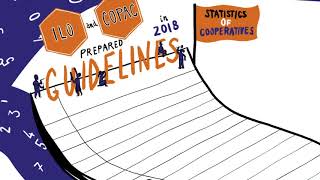The Guidelines concerning Statistics of Cooperatives
Adoption of the Guidelines
Statistics on cooperatives are essential to quantify the impact of cooperatives on their members and the economy as a whole. However, reliable and comparable statistics on cooperatives are missing in most countries of the world.
The Promotion of Cooperatives Recommendation no. 193 adopted by the ILO in 2002 states that national policies should “seek to improve national statistics on cooperatives with a view to the formulation and implementation of development policies”. To reaffirm this, at the 19th International Conference of Labour Statisticians (ICLS) in 2013 included cooperatives in the Conference agenda for the first time in its history. The resolution gave the ILO a mandate to carry out further developmental work on the measurement cooperatives in collaboration with interested stakeholders.
With this mandate, the ILO, in collaboration with its constituents and a number of national and international partners, has been working towards developing guidelines on the measurement of cooperatives. These efforts have culminated in the adoption of the Guidelines concerning Statistics on Cooperatives at the 20th ICLS which were then approved by the Governing Body of the ILO in March 2019. This is first version of an international norm on statistics on cooperatives.
What are the Guidelines about?
The Guidelines cover concepts and definitions, types of cooperatives, statistical units, and other relevant topics, including work in cooperatives.
- The section on ‘Reference concepts and definitions’ introduces the internationally agreed upon definition of cooperatives. It elaborates on how cooperatives relate to the Systems of National Accounts (SNA) which is an internationally agreed upon standard on how to measure economic activity at the national level.
- The section on ‘Types of cooperatives’ suggests four main types of cooperatives based on the main interest of the members of cooperatives and elaborates each type. The four main types of cooperatives are producer cooperatives, worker cooperatives, consumer cooperatives, and multi-stakeholder cooperatives. This categorization does not exclude compiling cooperative statistics by the branch of economic activities based on the SNA statistics system in parallel.
- The section on ‘Operational definitions’ provides guidance on how to identify cooperatives in statistical terms. It indicates that cooperatives should be formally established institutional units; should be controlled democratically by their members; should have voluntary and non-restrictive membership; and should distribute their profits or surplus among members, not directly linked to the capital contributed by each member.
- The section on ‘Work in cooperatives’ deals with how to measure all forms of work undertaken by members and non-members in cooperatives in line with the resolution concerning statistics of work, employment and labour underutilization adopted by the 19th ICLS in 2013 and other relevant international standards on work and employment.
The Guidelines also touch upon ways of collecting, tabulating, and analysing statistical data on cooperatives. It recommends collection of information on different types of cooperatives giving consideration to different characteristics of cooperatives through the use of a cooperative census.
Finally, the Guidelines call for the ILO to conduct further work on their implementation including through pilot testing, developing measures to assess the economic contribution of cooperatives, and dealing with the issue of cooperative-like and non-registered establishments.
Future plans
After the approval of the Guidelines, an short briefing note was drafted regarding the follow-up steps on how to implement the Guidelines in response to external requests during the first half of 2019. This note was shared with relevant stakeholders including COPAC (The Committee for the Promotion and Advancement of Cooperatives) members, its Technical Working Group (TWG) participants, and other relevant organizations based on request.
It was agreed through a series of consultations that the ILO would develop a manual that provides technical guidance for producing statistics on cooperatives at the institutional, national, regional and global levels. The manual will be informed by the outcome of pilot testing through multiple country cases. The manual concerning statistics of cooperatives would be prepared for review and discussion at the 21st IC LS in 2023. In this process, the ILO stands ready to collaborate with relevant stakeholders including COPAC and its TWG members, practitioners, experts in this field and responsible national authorities including national statistical offices.
We welcome all interested stakeholders to join us in this work. To get involved, please contact us at coop@ilo.org and visit our website at www.ilo.org/copac

